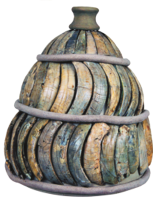Exhibit gives Greek art a fair shake
Nanjing Museum highlights power of Athenian art, Zhao Xu reports.

Aman, probably in his early 20s, with short curly hair and a mantle draped over his left shoulder is accompanied by a dog. He is facing a bearded, much more mature-looking man donning a longer mantle baring his chest.
Shown in profile on a marble stele dating to around 400 BC, the two are in the middle of a handshake, with both holding out their right hands.
"This was no handshake in the common sense of the word, but one that allowed a father to say a proper goodbye to his beloved son, who passed at his prime," says Guan Lin, curator of an ongoing exhibition, The Glory of the Aegean Sea, dedicated to ancient Greek civilization at the Nanjing Museum.
"In ancient Greek funerary art, the handshake is a gesture of final farewell, with the departed extending his or her right hand," she says.
"This marble relief is a grave stele found in Athens near a seaside church."
A viewer, who looks closely enough, will find a small box dangling from the father's wrist.
Known as aryballos, it was for holding olive oil typically used by athletes before and after exercises. It is within the keeping of the father as a reminder of all the athletic activities no longer performed by his son.
If it is within the capacity of a powerful work of art to move, this one certainly does it in a highly restrained way — there's no explicit reference to death.
Another exhibit on view at the Nanjing Museum that has shed considerable light on the power of Grecian art is a marble female figurine dating to a period between 2800 BC and 2300 BC.
With her gender indicated as much by protruding breasts as by the inverted pubic triangle, the figurine demonstrates an artistic brevity that would have lived up to the intense scrutiny of any modern art critic.
Yet the most powerful examples of the Grecian way of merging art with living are to be found on ancient Greek potteries.
"Wrapped-around canvases, this pottery art depicts every aspect of the Grecian existence and every character who had populated the Greek narrative, be it history or mythology," says Guan, pointing to a few pottery pieces on display that have as their themes a funerary procession, a boxing match and a struggle between Minotaur and Theseus, a divine hero who eventually subdued the human-bodied, bull-headed monster.
Ancient Greece was a land of stories, and the best of all its storytellers was Homer, who lived around the eighth century BC and whose two epic poems — Iliad and Odyssey — are considered the foundational works of not only Greek but also Western literature.
Homer wrote with such bristling details about the Trojan War, fought between the Greek forces and the city of Troy, arguably located in Hisarlik in modern-day Turkiye, that archaeologists and historians who came millennium later found it hard to believe that the author had written purely from imagination.
One of them was renowned German archaeologist Heinrich Schliemann, who was tempted to name a gold mask he unearthed from a burial ground in Mycenae in 1876 "The Mask of Agamemnon", after the legendary Mycenaean king who, in Homer's Iliad, commanded the Greek forces during the Trojan War. Mycenae is a prehistoric Greek city located in Peloponnese Peninsula and celebrated by Homer as "rich in gold".
The mask, found laid over the face of a dead person considered a member of Mycenaean royalty, dates to the 16th century BC and is believed to have nothing to do with Agamemnon, even if the man existed. Yet it has retained its glorious name nonetheless.
At the Nanjing Museum exhibition, a copy of the mask created by Swiss artist Emile Gillieron (1850-1924), who once acted as the Greek royal family's official painter, is on view, a reminder of the real-world splendor that fueled Homer's unfailing imagination.
"Meriones gave Odysseus a bow and quiver, and a sword, and on his head, he set a helmet made of hide, with many a tight-stretched thong within; without, the gleaming tusks of a white-tusked boar were set thick on this side and that …" wrote Homer in Book 10 of Iliad.
A helmet "made of hide" and covered with "the gleaming tusk of a white-tusked boar" — exactly as described by Homer — can be seen at the Nanjing Museum exhibition.
"The making of such a helmet required the hunting of approximately 50 wild boars, a fact that made the battle headgear a piece of luxury, as well as a showcase of bravery and strength," says Guan.
Although Homer's Iliad and Odyssey belonged to an earlier tradition of oral storytelling, they greatly influenced Greek tragedy, a core part of the ancient Greek theater that originated in Athens around the 5th century BC.
Part of the religious festivals dedicated to Dionysus, the god of wine who was given a nod in a controversial scene featured in the opening ceremony of the Paris Olympics, the ancient Greek theater was anything but frivolous.
In fact, it was meant to give moral lessons, to provide political commentary, and to make the Athenians more aware of their civic duties, which included the keeping of justice.
A water clock dating to the 5th century BC and on view at the Nanjing Museum was used to time speeches during law proceedings conducted in an Athenian court. According to Guan, the allotted duration of the speech was proportional to the seriousness of the case.
"An experienced speaker could tell the time remaining by observing the dwindling water pressure", referring to the fact that the water clock comprised two vessels placed at different levels, and that one must end his address the moment the water from the higher vessel had flowed completely into the lower one.
All the judges in Athenian courts were chosen by lot, the same way the Athenian tribes picked their representatives to form the Boule, or the Council of Citizens, which played a crucial role in the governance of the city.
"Justice in the life and conduct of the state is possible only as first it resides in the hearts and souls of the citizens," said Plato.


































